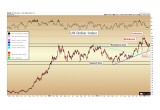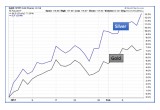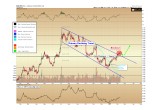
Generally speaking, a falling US dollar will cause prices of commodities and international trade items to be more expensive as priced in the falling currency.
What happens with the US dollar over the next two months is going to be extremely important not only for the precious metals themselves, but for most world commodities and currencies. The world’s reserve currency is at a critical juncture, and we still see few mainstream analysts discussing the ramifications for what appears to be a reversal lower in the works for the dollar -- either imminently, or at the latest by end-2017.
For reference, the dollar had been consolidating for nearly two years between 92 and 100 on the US Dollar Index, shown below. In November, that consolidation broke out to the upside, which corresponded with the weakness seen in precious metals late in the year.
This past week we have seen a bounce in the dollar at the lowest possible technical level for us to consider the November 2016 breakout in the Dollar Index to still be valid. Specifically, after falling for the last five weeks, the dollar rebounded at 99.5 and closed the week higher by 0.9%, to finish at 100.8 on the Index.
The medium-term perspective is updated below:
Image A
Even though the dollar held at the lowest threshold where we could still consider its breakout to remain valid (99.5) the US currency is looking increasingly fragile from a technical standpoint.
The weakness of the breakout is not indicative of a market prepared to move higher over the long run.
As an important data point: the most recent low of 99.5 (second retest of the breakout) matched exactly the level of the first retest from November 2016.
We thus do not have a higher low in the US Dollar Index following the initial breakout. New bull markets, especially in their early stages, should be characterized by higher highs and higher lows for medium-term pivots.
A breakout from a two-year consolidation should feature an impulsive move higher, and subsequent retests (lows) should come at sequentially higher levels.
Again, at this time we can observe that the most recent low in the dollar was not higher than the December low.
This is negative technical divergence – and it leads us to suspect a reversal lower of a multi-year magnitude is in the early formation stages. The only question is: does sustained dollar weakness materialize within the next two months, or will a grinding advance continue for the remainder of this year first?
We do not have enough data yet to answer that question; however, those with an eye for long-term secular trends in the commodity and currency markets should be paying attention to this action in the US dollar very closely.
Silver to Be a Major Beneficiary
If there is to be a falling US dollar backdrop either soon or within the next year, we would expect inflation to begin to pick up in the United States. Generally speaking, a falling US dollar will cause prices of commodities and international trade items to be more expensive as priced in the falling currency.
Image B
Precious metals should “sniff” this inflation out ahead of time, like a well-trained hound.
Further, in an inflationary environment, silver should outperform gold on a relative basis, as the former has greater industrial usage in electronics and solar fabrication -– industries which would be supported by overall rising prices.
Such is exactly what we observe since the recent December 2016 lows, as silver has outperformed gold by over 5.3% in less than two months.
Silver Recent Technical Analysis
Looking at the week as a whole, silver finished higher by $0.45 cents or 2.6% to close at $17.93 as of the final trade on the New York COMEX on Friday.
The advance in silver spot price this week resulted in a break of the best-fit trendline of the primary declining channel that we have been observing since early July (royal blue trend channel). This is a positive sign for the entire precious metals complex, and continues to strengthen the legitimacy of the breakout we saw above the $17.25 (black horizontal line) resistance two weeks prior.
Image C
Silver looks healthy at this juncture, and despite the continued rise from the December lows, we observe that the RSI indicator (top of chart) it not yet at an overbought reading, as it was during intermediate peaks in 2016. Silver appears to have more room to run on this advance.
We should expect some grinding price action with short 2-3 day corrections over the next two weeks as traders ascertain the legitimacy of the breakout.
Silver should be supported at $17.00 - $17.25 on any weakness.
Our near-term target for silver is $18.75, after which we will evaluate the possibility of an intermediate correction.
Christopher Aaron,
Bullion Exchanges Market Analyst
Christopher Aaron has been trading in the commodity and financial markets since the early 2000's. He began his career as an intelligence analyst for the Central Intelligence Agency, where he specialized in the creation and interpretation of the pattern of life mapping in Afghanistan and Iraq.
Technical analysis shares many similarities with mapping: both are based on the observations of repeating and imbedded patterns in human nature.
His strategy of blending behavioral and technical analysis has helped him and his clients to identify both long-term market cycles and short-term opportunities for profit.
Share:




